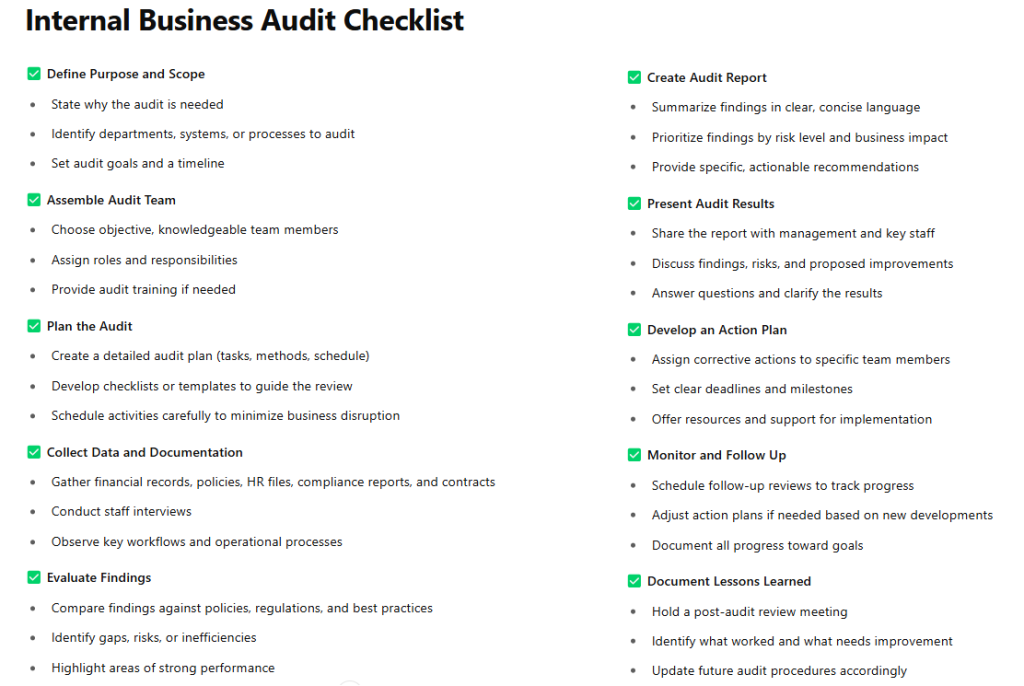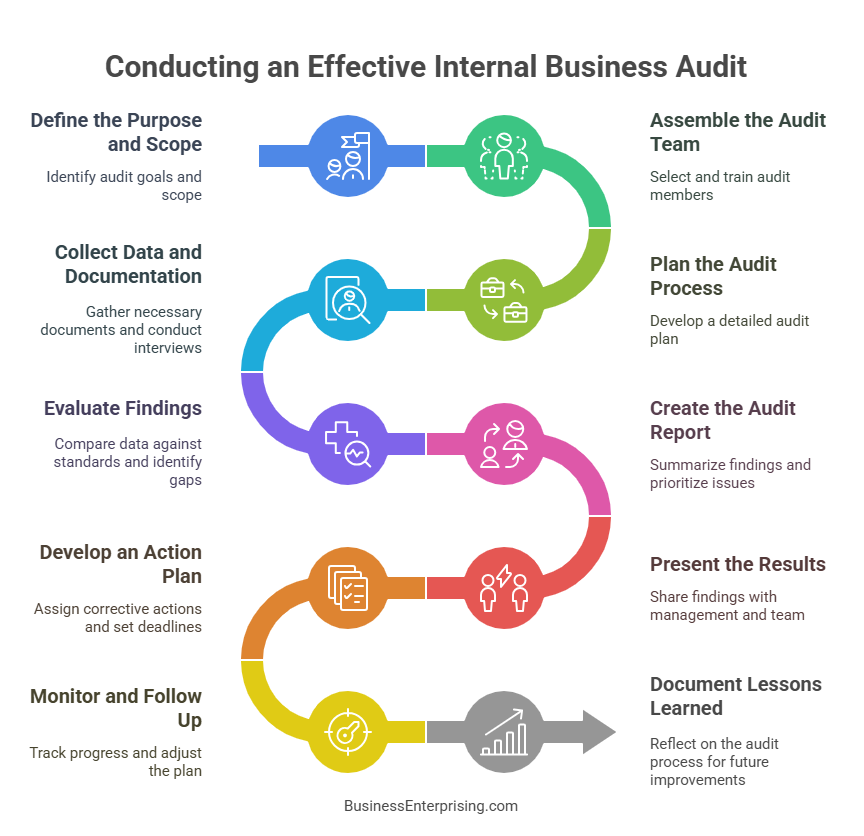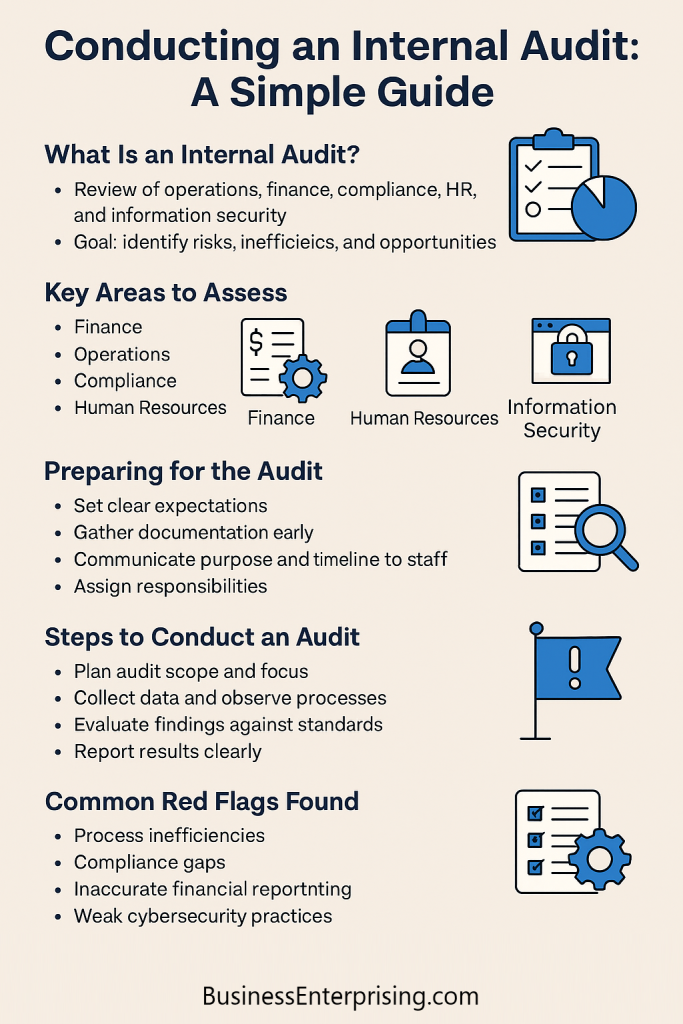
Additionally, internal audits help you find risks, spot inefficiencies, and strengthen operations before bigger problems arise. Therefore, an audit is not just about compliance; it is also about building a stronger, more competitive business. You gain clearer insights into how well your systems, teams, and processes perform every day.
However, a successful audit requires preparation and open communication. You should involve key team members early and set clear goals for the audit. Additionally, gathering documents, reviewing workflows, and asking the right questions helps you complete the process smoothly. Each step builds a better understanding of your company’s strengths and gaps.
Therefore, by conducting regular audits, you protect your company’s resources, reputation, and future growth potential. Additionally, you set a higher standard for performance across your teams. An internal audit may seem detailed and time-consuming, but it becomes easier with practice and a strong action plan. Starting small can still create meaningful improvements.
What Is an Internal Business Audit and Why It Matters
An internal business audit is a structured review of your company’s operations, financials, and compliance practices. Conducting an internal business audit helps you identify areas that need improvement or adjustment. However, an audit is not just about finding mistakes. It also highlights what is working well across departments.
Additionally, internal audits provide valuable insights that strengthen decision-making. You can spot risks early and fix problems before they grow larger. Therefore, regular audits help maintain operational stability and financial health. They also build confidence among employees, leadership, and any external partners who rely on your company’s integrity.
The process typically involves reviewing financial records, assessing internal controls, and analyzing policies and procedures. However, a well-done audit should also examine workflow efficiency and resource use. Additionally, it can assess whether your business is meeting industry standards and legal requirements.
By conducting audits internally, you gain a deeper understanding of your business operations. Therefore, you can make changes based on facts, not assumptions. You also reduce the risk of external audits revealing problems that could have been corrected earlier. Additionally, regular audits promote accountability across all levels of your organization.
Small issues often grow into larger problems if left unchecked. Conducting an internal business audit allows you to catch these issues early. With clear findings in hand, you can create specific action plans. That way, your business stays prepared for future growth, change, and new opportunities.
Key Areas to Assess During an Internal Audit
When conducting an internal business audit, it is important to review several key areas that affect overall operations and performance. Finance should always be one of the first categories you assess. You need to review accounting records, expense reports, and cash flow management practices. However, simply checking the numbers is not enough. You should also assess internal controls that protect financial assets.
Operations represent another critical area. Therefore, take a close look at workflow processes, supply chain management, and quality control systems. Additionally, review how resources are allocated to different projects or departments. Finding small inefficiencies early can lead to significant cost savings over time.
Compliance is another area that requires special attention. Additionally, verify that your business is following legal regulations, licensing requirements, and internal policies. Missing a small compliance detail can quickly escalate into serious problems later. However, staying ahead of requirements helps protect your business reputation.
You should also review human resources practices. Pay close attention to hiring procedures, training programs, and employee record-keeping. Additionally, assess if HR policies are applied consistently across your organization. Strong HR practices reduce legal risks and improve employee satisfaction.
Finally, information security has become an essential part of every internal audit. Therefore, check how sensitive data is stored, accessed, and protected. Cybersecurity threats evolve quickly, so regular reviews help safeguard business and customer information. Conducting an internal business audit across these areas helps you build a stronger, more resilient organization. Small improvements in each category add up to major long-term gains.
How to Prepare Your Team for an Internal Audit
Preparing your team for an internal audit starts with setting clear expectations. You need to explain why the audit is happening and what it involves. Therefore, make sure every department understands the purpose is improvement, not punishment. Additionally, highlight how conducting an internal business audit supports company goals and operational success.
Before the audit begins, gather the necessary documentation. Financial records, policies, training logs, and compliance files should be organized and up-to-date. However, avoid overwhelming your team with last-minute requests. Instead, create a checklist early and assign responsibilities. This approach reduces stress and keeps the audit moving efficiently.
Additionally, communicate openly about the process and timeline. Let staff know when auditors will review their areas and what materials may be requested. Therefore, encourage questions and provide a point of contact for any concerns. Transparency builds trust and cooperation across departments.
You should also conduct a brief training session if needed. Reviewing audit basics can help staff feel more comfortable and confident. However, keep sessions short and focused. Aim to reinforce the idea that audits support the company’s long-term success.
Finally, thank your team in advance for their participation. Recognizing their role builds a positive attitude toward the process. Preparing your staff well will lead to a smoother, more productive audit. Additionally, it can reveal areas for ongoing improvement beyond the current review.
Steps to Conduct an Effective Internal Audit
Conducting an internal business audit starts with careful planning. First, define the audit’s objectives and scope based on business needs. However, avoid trying to audit everything at once. Focus on the areas with the greatest impact on operations, finance, and compliance.
Additionally, create a clear audit plan that outlines tasks, deadlines, and responsible team members. Once planning is complete, move into the data collection phase. You should gather relevant documents, interview staff, and observe daily processes. Therefore, use checklists to make sure nothing important is overlooked during data gathering.
After you collect data, the next step is evaluation. Review the information carefully and compare it against company policies, industry standards, and regulatory requirements. However, keep an open mind during this phase. Look for strengths and opportunities for improvement, not just problems.
Once evaluation is complete, you need to prepare a detailed audit report. Additionally, summarize key findings, highlight urgent issues, and recommend corrective actions. A clear, concise report helps leadership make better decisions quickly. Therefore, use simple language and organize results by priority.
Finally, follow-up is an essential step that many businesses miss. You should schedule time to review progress on corrective actions. Additionally, keep communication open with all teams involved. Effective follow-up shows that the audit process drives real improvements across your business.
Taking these steps when conducting an internal business audit will help strengthen your operations and support long-term success.
Common Red Flags Identified During Internal Audits
Conducting an internal business audit starts with careful planning. First, define the audit’s objectives and scope based on business needs. However, avoid trying to audit everything at once. Focus on the areas with the greatest impact on operations, finance, and compliance.
Additionally, create a clear audit plan that outlines tasks, deadlines, and responsible team members. Once planning is complete, move into the data collection phase. You should gather relevant documents, interview staff, and observe daily processes. Therefore, use checklists to make sure nothing important is overlooked during data gathering.
After you collect data, the next step is evaluation. Review the information carefully and compare it against company policies, industry standards, and regulatory requirements. However, keep an open mind during this phase. Look for strengths and opportunities for improvement, not just problems.
Once evaluation is complete, you need to prepare a detailed audit report. Additionally, summarize key findings, highlight urgent issues, and recommend corrective actions. A clear, concise report helps leadership make better decisions quickly. Therefore, use simple language and organize results by priority.
Finally, follow-up is an essential step that many businesses miss. You should schedule time to review progress on corrective actions. Additionally, keep communication open with all teams involved. Effective follow-up shows that the audit process drives real improvements across your business.
Taking these steps when conducting an internal business audit will help strengthen your operations and support long-term success.
Turning Audit Findings Into Actionable Improvements
Finding problems during an audit is only valuable if you take action to correct them. Therefore, you need to prioritize audit results based on risk and impact. Address the issues that could cause the most damage first. However, do not ignore smaller findings that could grow into bigger problems later.
Additionally, creating a realistic action plan is key. Assign specific tasks, deadlines, and team members to each finding. Therefore, everyone knows what needs to happen and when. You should also set milestones to track progress along the way. Clear accountability keeps improvements moving forward.
Communication matters once you start implementing changes. Therefore, update your team regularly on what has been fixed and what still needs attention. Additionally, celebrate small wins when improvements are completed. Positive reinforcement helps maintain momentum across your organization.
However, you should be flexible as you work through your plan. Sometimes new information surfaces that shifts your priorities. Therefore, be ready to adjust timelines or approaches when needed. Staying rigid can cause delays or missed opportunities.
Conducting an internal business audit is the first step to improving operations. However, real value comes from acting on what you learn. By turning findings into actionable improvements, you strengthen your systems, lower risks, and build a more efficient organization. Additionally, you set a strong example that encourages continuous improvement.
Conclusion
Conducting an internal business audit is one of the smartest steps you can take to strengthen your company’s future. However, the real impact comes from acting on what you find during the audit. Therefore, make it a regular part of your operations, not just a one-time event.
Additionally, focus on using audits to build a culture of improvement across your business. Staff should view audits as a helpful tool, not a punishment. Therefore, communicate clearly and involve your team at every stage of the process. Small changes often create the biggest results over time.
However, preparation matters just as much as execution. You should plan carefully, gather the right information, and document everything you discover. Additionally, clear reporting and follow-up help you turn insights into practical improvements. Every audit you conduct makes your systems stronger and more efficient.
Therefore, treat every audit as an investment in your company’s stability, growth, and future success. Conducting an internal business audit is not just about spotting problems. It is about finding ways to optimize operations and lower risks before they impact your goals. Additionally, businesses that audit regularly stay better prepared for change and challenges ahead.




